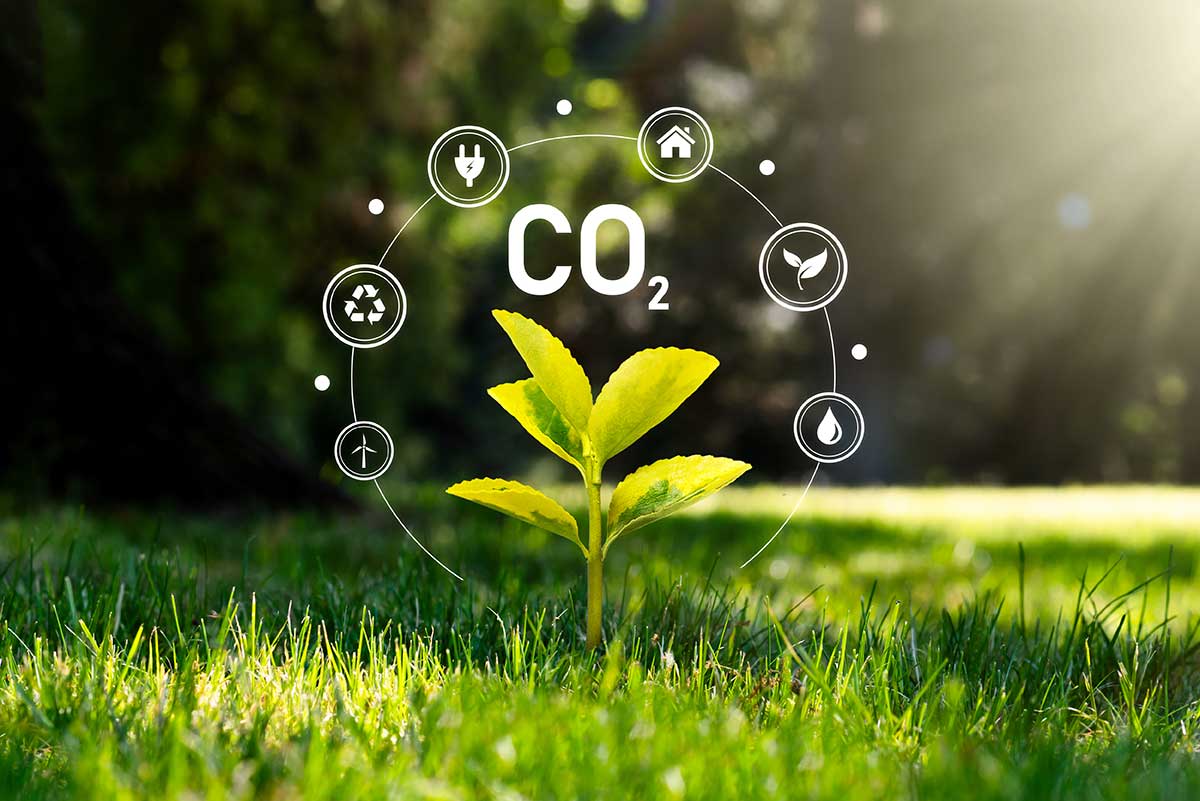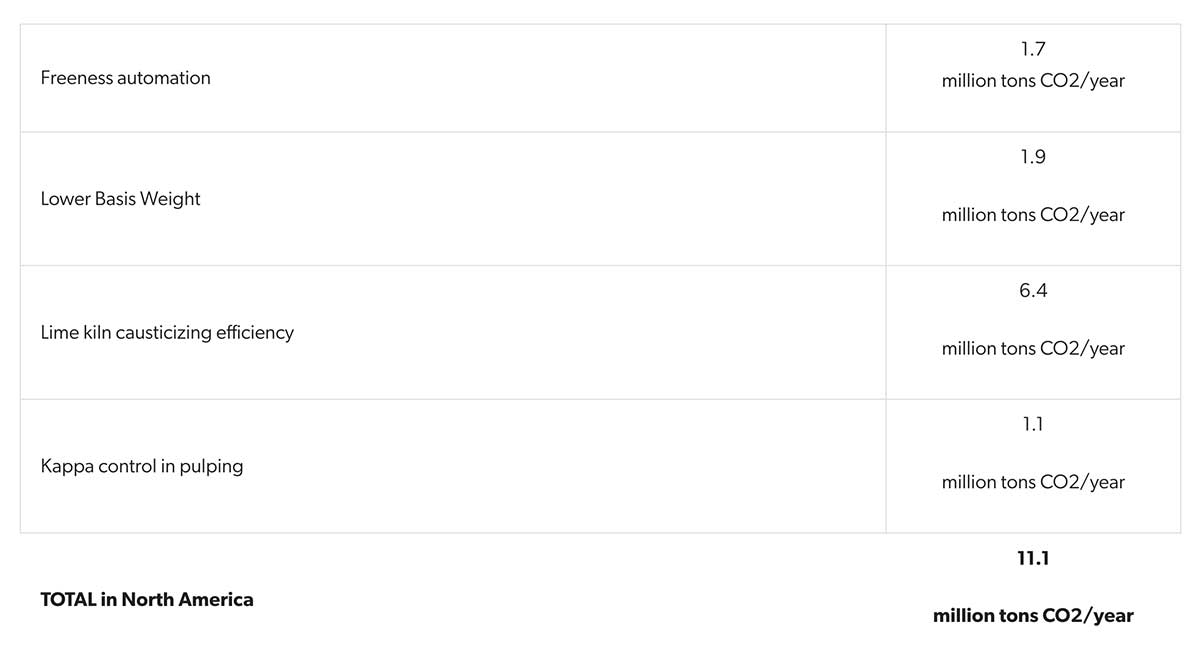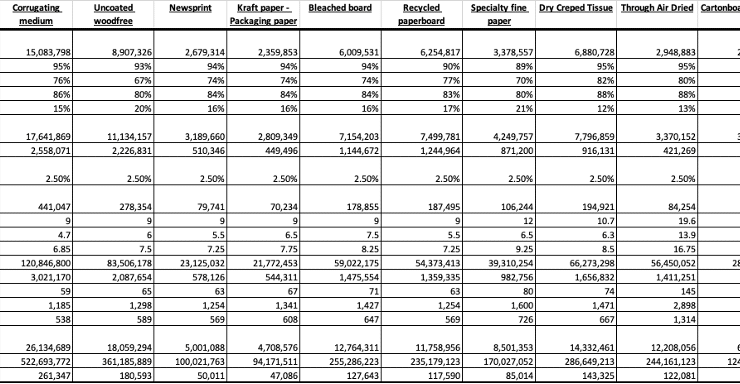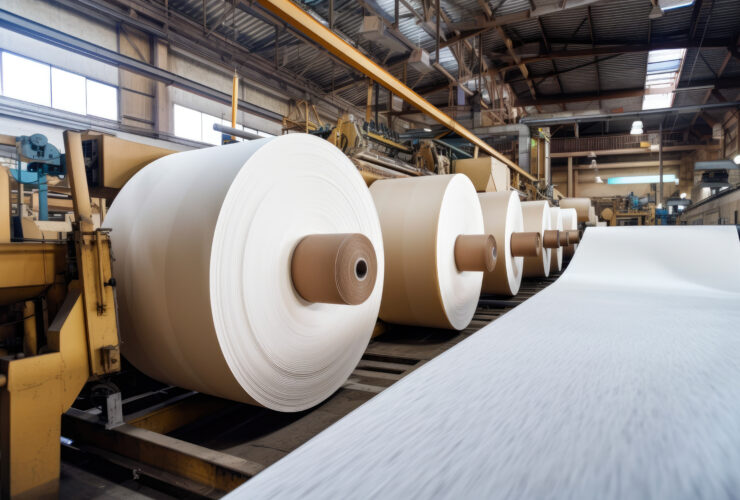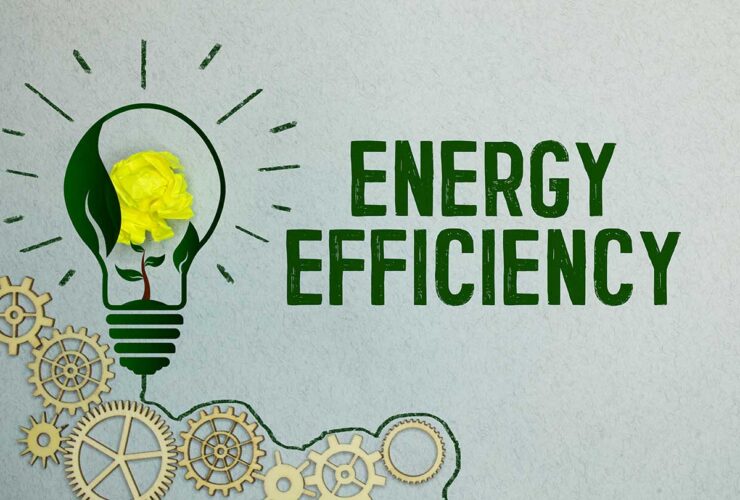In the prior analysis, we showed how automation of freeness can reduce North American CO2 generation by 1.7 million tons per year. Given that the 2021 EPA reported CO2 emissions in the United States were 34.9 million tons (1), there may be additional CO2 reductions possible. This document will show some additional capabilities Pulmac is uniquely able to provide. This is not meant to be a comprehensive account of every potential CO2 reduction Pulmac can offer but is meant to account for some of the major categories in the paper industry and the general magnitude of potential benefit in each.
Paper mill lower basis weight
The most common specification for a sheet of paper is basis weight and moisture. Basis weight is the weight of a sheet per unit area, which includes moisture. The moisture content of a sheet of paper is typically 5% to 8% of the weight of the sheet. Therefore, during the papermaking process, there are automated systems using basis weight and moisture measurements as their targets to ensure production meets these specifications.
However, the quality requirements for a sheet of paper are often stated in terms of required mechanical properties. Depending on the grade, differing strength requirements such as tensile, burst, tear, and others are specified. These requirements can be more important than meeting precise basis weight or moisture targets.
Why doesn’t the industry just use these strength specifications for their targets? The reason is there are no online sensors that can measure strength properties. Therefore, papermakers often make a sheet at a sufficiently high basis weight and low moisture to ensure the strength properties are met. This means the energy demand to dry a heavier sheet to a lower moisture content might result in a higher than optimal CO2 demand.
However, Pulmac can predict these strength measurements with the use of PulpEye. PulpEye data provides important properties of fibers that are very significant in determining the strength of the finished product.
PulpEye data can be combined with other process data in Seeq to derive prediction models of strength properties. These models can be used to find optimal settings for refiners, chemicals, furnish blends, and other variables to meet strength properties at lower basis weight and higher moisture content, reducing drying energy and CO2 emissions.
Advanced control techniques are then used to automatically maintain the process at these optimal operating points.
While each grade and machine will have unique conditions and differing benefits, a reasonable assumption is that the same cumulate area of the sheet can meet strength specifications with optimally set variables at 0.5% lower basis weight. In the prior analysis, we used the current North American paper capacity from FisherSolve of 89,823,364 finished short tons/year (2), and subtracted the recovered production due to freeness automation of 2,675,665, to yield 87,147,699 finished short tons/year. If we reduce this by another 1% in basis weight (435,738 tons/year), we have 86,711,960 finished short tons/year.
Using an industry average of 8.58 MBTU/gross ton (3), that amounts to a savings of 3,739,181 MBTU/year, which is 323,459 tons of CO2/year.
However, we are not done with basis weight savings. Pulmac’s patented GluPulp process enables fibers to be developed with much greater bonding strength. Based on trial results, it is expected that GluPulp can allow basis weight reduction of more than 2.5% while still meeting strength targets. GluPulp may also decrease drainage on the machine, which ordinarily would require more drying energy, but at lower basis weight there is less water going to the machine so this drainage effect would likely cancel out. A 2.5% lower basis weight would reduce North American production from 86,711,960 finished short tons/year by 2,167,799 tons/year.
Using similar calculations to the above, this is a reduced energy demand of 18,602,425, equating to 1,609,206 tons of CO2/year.
The expected net result of optimization with PulpEye, Seeq, and automation combined with GluPulp is a reduction of 1,932,665 tons of CO2/year.
Chemical recovery using RedEye
According to FisherSolve (2), 56% of North American pulp production uses chemical processes, accounting for 59,433,206 air-dried short tons/year. With some exceptions, the dominant chemical process used in pulping is the Kraft process. In the Kraft process, a lime kiln is used to regenerate caustic used in the process. A lime kiln is the highest fossil fuel-using process in kraft pulp mills, and there are over 250 lime kilns in operation in North America (4).
Typically, the causticizing efficiency in this process has been 75%, meaning that 25% of the available chemical is not converted into a usable chemical for pulping. This means that more chemical needs to be fed into a lime kiln to generate sufficient caustic, meaning more energy demand for the lime kiln.
The problem has been the lack of online measurement. Without knowing the causticizing efficiency and pertinent characteristics of the chemistry, adjustments cannot be made.
RedEye is an online analyzer for pulping liquor from PulpEye. With RedEye, it is possible to take typically 75% causticizing efficiency up near the theoretical limit of 82%. A 1000 air dry ton/day pulp mill operating at 82% causticizing efficiency is expected to produce 236 tons CO2/day (4). In practice, kilns in the industry are generating anywhere from 290.7 to 395.2 tons of CO2/day (4). Using a median figure of 342.95 tons CO2/day for a 1000 air dry ton/day pulp mill, improving causticizing efficiency to 82% would eliminate 106.95 tons CO2/day. To calculate the impact in North America, we have:
Pulping using PulpEye to measure Kappa
In the Kraft pulping process, the objective is to remove sufficient lignin to separate individual wood fibers. Lignin is a gluelike substance that can be measured with a test known as Kappa. A low Kappa number means a small amount of residual lignin remains on the fibers.
Like with the lime kiln, there are not typically online measurements of the Kappa number. Advanced controls in pulping use temperature and time calculations (H factor) and additional chemicals in proportion to the production rate. However, variations in the nature of wood often mean additional chemicals or heat are added to ensure Kappa does not get too high.
Pulmac can offer PulpEye to measure Kappa online. This allows controls to be tighter, which can reduce energy and chemical demand while boosting yield. The reduced chemical demand will provide additional savings to the downstream lime kiln, as described above.
It is more difficult to derive estimates of these CO2 benefits, but Pulmac’s ability to combine PulpEye measurement of Kappa with advanced controls and data analytics provides a unique capability for CO2 savings in Kraft pulping.
The Kraft process has an electricity demand of 2.34 MMBTU/air-dry short ton and a steam demand of 19.3 MMBTU/air-dry short ton (5) for a total of 22 MMBTU/air-dry short. Using 59,433,206 air-dried short tons pulp/year in North American kraft pulp production if we increase yield by 1% due to a target shift of Kappa number, we reduce Kraft pulp demand by 594,332 air-dried short tons pulp/year.
This means a savings of 12,864,145 MMBTU/year, which is a reduction of 1,112,815 tons CO2/year.
Conclusion
Pulmac is uniquely capable of offering CO2 reductions in the North American paper industry as follows:
The cases listed above do not exclude other opportunities for CO2 reductions. There are certainly other cases in which Pulmac has the capability to accomplish this, but it may be more difficult to predict those reductions than in the cases included above. Current developments of artificial intelligence applications in the industry have shown that significant energy reductions through optimization of operating conditions are feasible. The CO2 reductions analyzed here are a conservative estimate based on currently available data. We may find that the potential is much higher as more research and industry experience accumulates.
(1) “AVAILABLE AND EMERGING TECHNOLOGIES FOR REDUCING GREENHOUSE GAS EMISSIONS FROM THE PULP AND PAPER MANUFACTURING INDUSTRY”, EPA, October 2010
(2) FisherSolve
(3) TAPPI TIP 0404-47 “Paper Machine Performance Guidelines”
(4) “The Carbon Footprint of Lime Kilns: Part 1 – Assessment of CO2 Emissions”
(5) “ENERGY ANALYSIS OF A KRAFT PULP MILL POTENTIAL FOR ENERGY EFFICIENCY AND ADVANCED BIOMASS COGENERATION”

